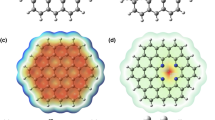Abstract
Density Function Theory (DFT) calculation was used to find out ground and excitation states for graphene ribbons, types of adsorption, energy gap, maximum wave length and optical band gap. Adsorption energy showed that CO2 gas molecule had chemical adsorption in distance 1 and 1.5 Angstrom. CO2 gas molecule appeared to have physical adsorption in distance 2 and 2.5 Angstrom. Adsorption energy decreased when the distance between surface and gas molecule increased. Resulting from chemical adsorption energy gap, there was a change in distance 1 and 1.5 Angstrom due to the attraction of gas molecule towards surface. Excitation energy for Nano system in samples 1 and 4 shifted to low wavelength (blue shift), changing from 1018 to 993 nm and 718 nm on series. Other sample had red shift and the energy gap became open. The result showed that graphene ribbon sensed carbon dioxide gas (CO2).






Similar content being viewed by others
References
Ao, Z.M., Jang, J., Li, S., et al.: Enhancement of CO detection in Al doped grapheme. Chem. Phys. Lett. 461(4), 276–279 (2008)
Batzill, M., and Diebold, U.: Surface studies of gas sensing metal oxides. Phys. Chem. Chem. Phys. 9 2307–2318 (2007)
Cox, A.: Introduction to quantum theory and atomic structure, lecture in organic chemistry. University of Oxford, England (1995)
Cox, P.A.: Introduction to quantum theory and atomic structure. Oxford University Press Inc., New York (1996)
Fitts, D.D.: Principles of quantum mechanics: as applied to chemistry and chemical physics. Cambridge University Press, New York (2002)
Hameka, H.F.: Quantum mechanics: a conceptual approach. Wiley, Leiden University (2004)
Harper, D.B.: Halomethane from halide ion-a highly efficient fungal conversion of environmental significance. Nature 315, 55–57 (1985)
Ji, E., Kim, M.J., et al.: Substrate effect on doping and degradation of grapheme. Carbon 184, 651–658 (2021)
Leenerarts, O., Partoens, B., et al.: Adsorpton of H2O, NH3, CO, NO2 and NO2 on graphene: a first principle study. Phys. Rev. B 77(12), 1–6 (2008)
Novikov, S., Lebedeva, N. et al.: Graphene-based sensor for environmental monitoring of NO2. Procedia Eng. 120, 586–589 (2015)
Novikova, S., Lebedevaa, N., et al.: Graphene based sensor for environmental monitoring of NO2. Sens. Actuat. B 236, 1054–1060 (2016)
Rad, A.S.: Al-doped graphene as a new nanostructure adsorbent for some halomethane compound: DFT calculations. Surf. Sci. 645, 6–12 (2016)
Raeyani, D., Shojaei, S., Ahmadi-Kandjani, S.: Optical graphene quantum dots gas sensors: theoretical study. Super Latt. 3, 321–330 (2017)
Safian, M.T., Umar, K., et al.: Synthesis and scalability of graphene and its derivatives: a journey towards sustainable and commercial material. J. Clean. Prod. 318, 1–17 (2021)
Smaradhana, D.F., Prabowo, A.R.: Exploring the potential of graphene materials in marine and shipping industries –a technical review for prospective application on ship operation and material-structure aspects. J. Ocean Eng. Sci. 6, 299–316 (2021)
Tang, C.L.: Fundamentals of Quantum Mechanics for Solid State Electronics and Optics. NY publishes, Ithaca (2004)
Yavari, F., Koratkar, N.: Graphene-based chemical sensors. J. Phys. Chem. Lett. 427(12), 1746–1753 (2012)
Yu, S., Wang, X., et al.: Boron– Ntride based materials for removal of pollutants from aqueous solutions, a review. Chem. Eng. J. 333, 343–360 (2018)
Author information
Authors and Affiliations
Corresponding author
Additional information
Publisher's Note
Springer Nature remains neutral with regard to jurisdictional claims in published maps and institutional affiliations.
Rights and permissions
About this article
Cite this article
Al-Hasnawy, R.S., Shaker, A.S., Albosaabar, M.H. et al. Design pollution gas sensor using graphene ribbon: density function theory (DFT). Opt Quant Electron 54, 65 (2022). https://doi.org/10.1007/s11082-021-03415-8
Received:
Accepted:
Published:
DOI: https://doi.org/10.1007/s11082-021-03415-8




